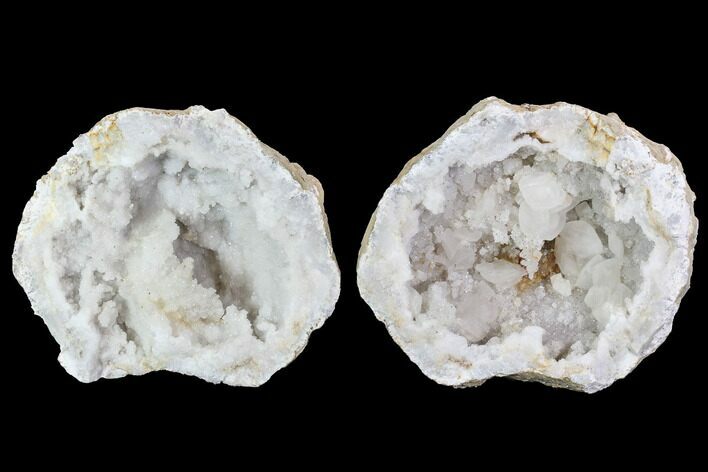This Specimen has been sold.
5.3" Keokuk Druzy Quartz and Calcite Crystal Geode Pair - Illinois
This keokuk geode was collected from Crystal Glen Creek in Hamilton, Illinois. The interior of the geode is lined with sparkling, druzy quartz and calcite crystals. The red within this geode can be attributed to the presence of oxidized iron. It comes with display stands.
Unlike most geodes that form in volcanic rock, Keokuk geodes are found in sedimentary rock. They started out as concretions of mud that formed around organic material about 340 million years ago. The outer shells of these concretions were subsequently replaced by chalcedony and the interiors of the concretions were dissolved, leaving a hollow space into which quartz crystals could grow. Most geodes are 2 to 5 inches wide, though specimens as large as two feet across have been found.
Keokuk geodes contain a variety of minerals, but quartz is dominant in most. Many geodes are filled with clear to white quartz crystals. Micro-crystalline quartz, or chalcedony, whose component crystals are too small to be seen with the naked eye, forms the outer shell. Chalcedony layers also encrust the interior walls of many geode cavities, covering the surfaces of the earlier-generation quartz crystals in a variety of colors, including white, gray, blue, yellow and orange. Calcite is also a common mineral in many geodes, though seventeen other minerals have been identified in Keokuk Geodes, including pyrite and sphalerite.
The area around Keokuk, Iowa is sometimes referred to as “the geode capital of the world". In 1967, these geodes were even named the official state rock of Iowa. Geodes have been collected from the Lower Warsaw Formation within about 100 miles of the city for over 150 years.
Keokuk geodes contain a variety of minerals, but quartz is dominant in most. Many geodes are filled with clear to white quartz crystals. Micro-crystalline quartz, or chalcedony, whose component crystals are too small to be seen with the naked eye, forms the outer shell. Chalcedony layers also encrust the interior walls of many geode cavities, covering the surfaces of the earlier-generation quartz crystals in a variety of colors, including white, gray, blue, yellow and orange. Calcite is also a common mineral in many geodes, though seventeen other minerals have been identified in Keokuk Geodes, including pyrite and sphalerite.
The area around Keokuk, Iowa is sometimes referred to as “the geode capital of the world". In 1967, these geodes were even named the official state rock of Iowa. Geodes have been collected from the Lower Warsaw Formation within about 100 miles of the city for over 150 years.
About Calcite Crystals
Calcite crystals are a form of calcium carbonate (CaCO₃) known for their diverse shapes, transparency, and vibrant range of colors. They typically form in rhombohedral, scalenohedral, or prismatic shapes, often with well-defined, sharp edges and glossy surfaces. Calcite crystals are often translucent or transparent, sometimes displaying a double refraction effect where objects viewed through the crystal appear doubled. They can appear in various colors—white, clear, yellow, pink, blue, green, and orange—depending on impurities or trace minerals.
A notable characteristic of calcite is its reaction with weak acids like vinegar, which causes it to effervesce, or fizz, as it releases carbon dioxide. This property makes calcite crystals a key tool in geological identification and studies. Calcite forms in many environments, from sedimentary rocks like limestone and marble to hydrothermal veins.
Calcite crystals are a form of calcium carbonate (CaCO₃) known for their diverse shapes, transparency, and vibrant range of colors. They typically form in rhombohedral, scalenohedral, or prismatic shapes, often with well-defined, sharp edges and glossy surfaces. Calcite crystals are often translucent or transparent, sometimes displaying a double refraction effect where objects viewed through the crystal appear doubled. They can appear in various colors—white, clear, yellow, pink, blue, green, and orange—depending on impurities or trace minerals.
A notable characteristic of calcite is its reaction with weak acids like vinegar, which causes it to effervesce, or fizz, as it releases carbon dioxide. This property makes calcite crystals a key tool in geological identification and studies. Calcite forms in many environments, from sedimentary rocks like limestone and marble to hydrothermal veins.
SPECIES
Quartz & Calcite
LOCATION
Crystal Glen Creek, Hamilton, Illinois
SIZE
5.3" wide
CATEGORY
SUB CATEGORY
ITEM
#91402
 Reviews
Reviews












